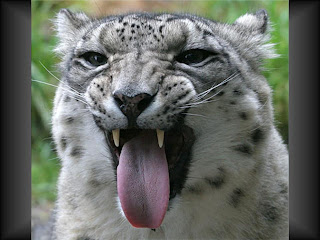The Snow leopard (Uncia uncia) is a state animal of Pakistan. Snow leopards live between 3,000 and 5,500 metres (9,800 and 18,000 ft) above sea level in the rocky mountain ranges of Central and South Asia. It has been estimated that between 3,500 and 7,000 snow leopards exist in the wild and around 300 are in Pakistan.
Snow leopards show several adaptations for living in a cold mountainous environment. The snow leopard has a short muzzle and domed forehead, containing unusual large nasal cavities that help the animal breathe the thin, cold air of their mountainous environment.In summer, snow leopards usually live above the tree line on mountainous meadows and in rocky regions at an altitude from 2,700 to 6,000 m (8,900 to 20,000 ft). In winter, snow leopards come down into the forests to an altitude of around 1,200 to 2,000 m (3,900 to 6,600 ft).
Snow leopards are smaller than the other big cats. They generally weigh between 27 and 55 kg (60 and 120 lb. Body length ranges from 75 to 130 cms (30 to 50 inches), with the tail adding a further 80 to 100 cm (31 to 39 in) to that length. These cats stand about 60 cm (24 in) at the shoulder.

Snow leopards have long thick fur, and their base color varies from smoky gray to yellowish tan, with whitish under parts. They have dark gray to black open rosettes on their body with small spots of the same color on their heads and larger spots on their legs. Their eyes are pale green or gray in color. Their bodies are solid with thick fur. Their ears are small and round .Their paws are wide, which distributes their weight better for walking on snow, and have fur on their undersides to increase their grip on steep and unstable surfaces; it also helps to minimize heat loss. Snow leopards' tails are long and flexible, helping them to maintain their balance, which is very important in the rocky terrain they inhabit. Their tails are also very thick due to storage of fats and are very thickly covered with fur which allows them to be used like a blanket to protect their faces when asleep.


Snow leopards cannot roar, despite possessing partial ossification of the hyoid bone. Larynx is absent in snow leopard which create ability to roar Sound is generated in the larynx, and that is where pitch and volume are manipulated. Snow leopard vocalizations include hisses, chuffing, mews, growls, and wailing. Prusten is a sound made by the snow leopard, also known as chuffing or chuffle The animal's mouth is closed and it blows through the nostrils, producing a breathy snort. This sound is non-threatening and often used when two big cats encounter each other on neutral territory, or between courting pairs.
Snow leopards usually mate in late winter, marked by a noticeable increase in marking and calling. The Snow Leopards have a gestation period of 90–100 days, so that the cubs are born between April and June.
The animals usually give birth to two to three cubs in a litter, but can give birth to up to seven in some cases.The mother gives birth in a rocky den or crevice lined with fur shed from her underside. Litter sizes vary from one to five cubs, but the average is 2.2. The cubs are blind and helpless at birth, although already with a thick coat of fur, and weigh from 320 to 567 grams (11 to 20.0 oz). The eyes open at around seven days, and the cubs can walk at five weeks and are fully weaned by 10 weeks. Also when they are born they have full black spots and turn into rosettes as they grow up The cubs leave the den at around two to four months of age, but remain with their mother until they become independent after around 18–22 months.

Snow leopards are carnivores and actively hunt their prey.They can kill animals three times their size but will readily take much smaller prey such as hares and birds. Snow leopards are crepuscular, being most active at dawn and dusk. They are known for being extremely secretive and well camouflaged. Snow leopards prefer to ambush prey from above, using broken terrain to conceal their approach, and can leap as far as 14 meters (46 ft).They kill with a bite to the neck, and may drag the prey to a safe location before feeding.
The snow leopard leads a largely solitary life. An individual snow leopard lives within a well-defined home range, but does not defend its territory aggressively when encroached upon by other snow leopards, snow leopards use scent marks to indicate their territory and common travel routes. These are most commonly produced by scraping the ground with the hind feet before depositing urine or scat, but they also spray urine onto sheltered patches of rock.
Snow leopards normally live for 15–18 years, although in captivity they can live for up to 21 years.
.





























